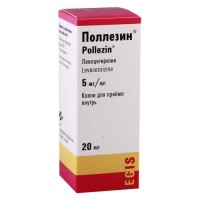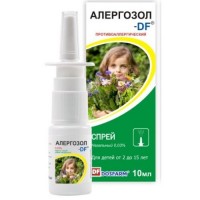Klarisan 10 mg (10 tablets)
- $7.30
The instruction for medical use of Klarisan® medicine the Trade name of Klarisan® the International unlicensed name Loratadin Lekarstvennaya a form of the Tablet of 10 mg Structure One tablet contains active agent - loratadin 10.03 mg (in terms of 100% substance of 10.0 mg), excipients: lactoses monohydrate, cellulose microcrystalline, potato starch, calcium stearate. The description of the Tablet of white or almost white color with a flat surface. On one party of a tablet there is a facet, on another - a facet and a signature logo in the form of a cross. Pharmacotherapeutic group Antihistaminic drugs of systemic action. Antihistaminic drugs of systemic action others. Loratadin the ATX R06AX13 Code the Pharmacological Pharmacokinetics Later properties of intake loratadin is quickly soaked up in digestive tract. Loratadin is metabolized in an active metabolite dezloratadin by means of P450 3A4 cytochrome and, to a lesser extent, P450 2D6 cytochrome. Time of achievement of the maximum concentration in blood plasma of a loratadin and dezloratadin is 1-1.5 and 1.5-3.7 hours respectively. Meal increases time of achievement of the maximum concentration (Tmax) of a loratadin and dezloratadin approximately for 1 hour, but does not affect its value and clinical effect of drug. The maximum concentration increases at patients with chronic kidney disease or alcoholic damage of a liver. Loratadin well contacts proteins of blood plasma (97-99%), his active metabolite dezloratadin - for 73-76%. The bioavailability of a loratadin and its active metabolite is proportional to the accepted dose. About 40% of drug are removed with urine and 42% - with a stake. Elimination half-life of a loratadin averages 8.4 hours (from 3 to 20 hours vary), and a dezloratadina – 28 hours (from 8.8 to 92 hours). Elimination half-life of a loratadin and dezloratadin increases in hepatic pathology in proportion to extent of damage of a liver. There are no differences in pharmacokinetic parameters of a loratadin and its metabolites at adult and elderly patients. Loratadin and his active metabolite are excreted in breast milk. The hemodialysis does not influence pharmacokinetics of a loratadin and its active metabolite at patients with chronic kidney disease. The pharmacodynamics the Selection blocker of peripheral H1-histamine receptors, has antiallergic, antipruritic, anti-exudative effect. The antiallergic effect develops within the first 30 minutes after administration of drug, reaches a maximum within 8-12 hours and 24 hours last. Does not influence the central nervous system, does not show anticholinergic and sedative action, does not influence the speed of psychomotor reactions at reception in a therapeutic dosage. Prevents development of allergic reactions and facilitates their course. Reduces permeability of capillaries and the increased sokratitelny activity of smooth muscles caused by action of a histamine is prevented by edematization of fabrics. Indications - for relief of symptoms of chronic and/or seasonal allergic rhinitis and allergic diseases of skin the Route of administration and doses Inside, in 15-30 minutes prior to meal. To adults and children 12 years are more senior: 10 mg (1 tablet) of 1 times a day. To children from 6 to 12 years: with the body weight & gt, 30 kg - 10 mg (1 tablet) of 1 times a day, with body weight ≤ 30 kg - 5 mg (½ tablets) of 1 times a day. The effect is shown in half an hour after administration of drug and remains for 24 hours. To patients with a liver failure appoint a half of the recommended dose (the adult ½ tablet or 5 mg) at daily reception or a full dose (1 tablets or 10 mg) every other day. And advanced age of dose adjustment is not required to patients with a renal failure. Side effects Seldom - a headache, increased fatigue, excitability at children - drowsiness - dryness in a mouth, nausea, gastritis - skin rash Isolated cases - an alopecia - anaphylactic reactions - disturbance of hepatic functions - tachycardia, heartbeat - Contraindication dizziness - raised by sensitivity to a loratadin or any other component of drug - the lactation period - the children's age up to 6 years Medicinal interactions At combined use with erythromycin, ketokonazoly and Cimetidinum increases concentration of a loratadin and its active metabolite in blood plasma, but it is not followed by clinical manifestations. The special instructions Klarisan® has no clinically significant sedative effect when using in the recommended doses (on 10 mg of 1 times a day). Drug does not exponentiate effect of alcohol. Reception of Klarisana® should be stopped in 48 hours prior to carrying out skin diagnostic allergoprob for prevention of obtaining false results. To patients with heavy disturbances of functions of a liver the smaller initial dose because of possible reduction of clearance of a loratadin has to be appointed (the recommended initial dose of 5 mg of 1 times a day or on 10 mg every other day). Drug contains lactose therefore to patients with hereditary intolerance of a galactose, the deficit of Lapp of lactase or malabsorption of a glyukozo-galactose do not recommend. The period of pregnancy and a lactation of Klarisan® is applied only in cases when the advantage of its use for mother exceeds possible harm for a fruit. Drug gets into breast milk therefore during treatment it is necessary to stop breastfeeding. The feature of influence of medicine on ability to run the vehicle or potentially dangerous mechanisms In the recommended doses of Klarisan® does not affect ability to run the vehicle or work with potentially dangerous mechanisms. However, patients have to be informed on a possibility of potential risk of development of drowsiness in case of drug overdose. Overdose Symptoms: drowsiness, tachycardia, headache. Treatment: symptomatic and maintenance therapy, gastric lavage, intake of the crushed activated carbon with water in the form of suspension. Loratadin is not brought by a hemodialysis. After rendering emergency aid the patient has to remain under observation of the doctor. A release form On 10 tablets in blister strip packaging from a film of polyvinylchloride and aluminum foil. 1 planimetric packing together with the approved instruction for medical use in the state and Russian languages is placed in a pack from cardboard. It is allowed to place planimetric packings in boxes of cardboard for a retail container or corrugated. Put the approved instructions for medical use in each box in the state and Russian languages. To Store storage conditions in the dry, protected from light place at a temperature not higher than 30 wasps. To store out of children's reach! 3 years not to apply a period of storage after an expiration date. Prescription status According to the prescription JSC Khimpharm Producer, Kazakhstan, Shymkent, Rashidov St.,/N, ph.: 560882 Owner of the registration certificate of JSC Khimpharm, Kazakhstan







